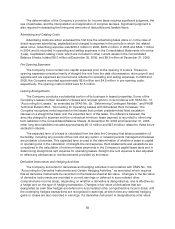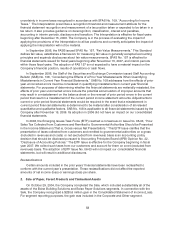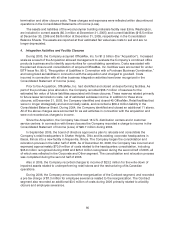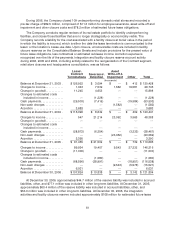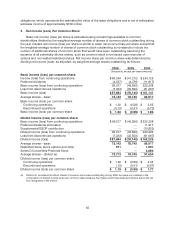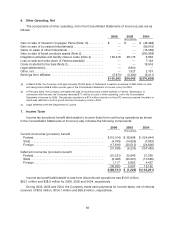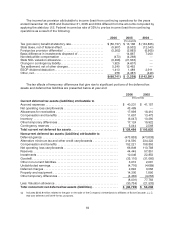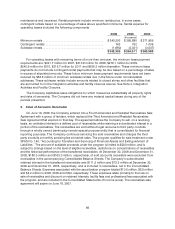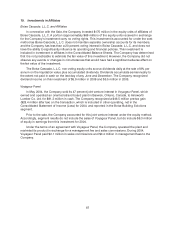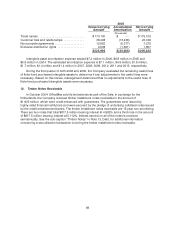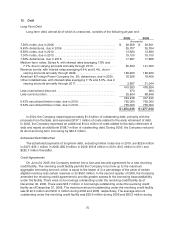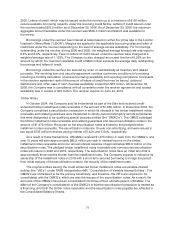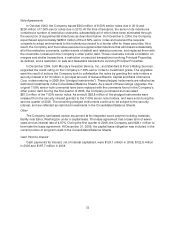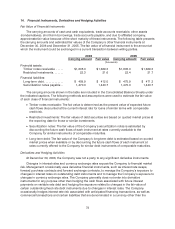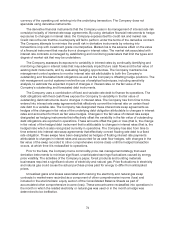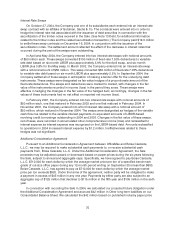OfficeMax 2006 Annual Report Download - page 69
Download and view the complete annual report
Please find page 69 of the 2006 OfficeMax annual report below. You can navigate through the pages in the report by either clicking on the pages listed below, or by using the keyword search tool below to find specific information within the annual report.
65
In assessing the realizability of deferred tax assets, management considerswhether it is more
likely than not that some portion or all of the deferred tax assets will not be realized. The ultimate
realization of deferred tax assets is dependent upon the generation of future taxable incomeduring
the periods inwhich those temporary differences becomedeductible.Management considers the
scheduled reversal of deferred tax liabilities, projected future taxable income, and tax planning
strategies inmaking this assessment.Management believes it is more likely than not that the
Company will realize the benefits of these deductible differences, except for certainstate net operating
losses as noted below. The amount of the deferred taxasset considered realizable, however, could be
reduced if estimates of future taxable income during thecarryforward period are reduced.
The Company has established a valuation allowance of$30.7 million related to net operating loss
carryforwards in jurisdictions where the Company has substantially reduced operations because
management believes it ismore likely than not that these items will expire before the Company is able
to realize their benefits. Periodically, the valuation allowance is reviewed and adjusted based on
management’s assessments of realizable deferred tax assets.
The Company has a deferred tax asset related to net operating loss carryforwards for Federal
income tax purposes of $68.2 million and $65.9 million at December 30, 2006 andDecember 31, 2005
respectively. These net operating loss carryforwards are available to offset future Federal taxable
income, if any, through 2025. As of December 30, 2006, the Company has alternative minimum tax
credit carryforwards of approximately $196.8 million,which are available to reduce future regular
Federal income taxes, ifany, over an indefinite period, and foreign tax credit carryforwards of
$11.8 million with an expiration date of 2016.The Company alsohas deferred tax assets related to
various state net operating losses of $24.3 million, net of the valuation allowance, that expire between
2007 and 2025.
Pre-tax income (loss) related to continuing operations from domestic and foreign sources isas
follows:
2006 2005 2004
(thousands)
Domestic ................................................ $124,643 $(65,073) $340,484
Foreign.................................................. 47,23527,457 38,958
Total pre-tax income (loss)................................. $171,878 $(37,616) $379,442
As of December 30, 2006, the Company had undistributed earnings and profits of foreign
operations of approximately $270 million. The Company hasnot provided any U.S. income tax related
to jurisdictions for which it has determined that it haspermanently reinvested its earnings. The
Company has provided for $4.7 million in Federal income taxes related to the anticipated repatriation
of earnings from its investment in aMexican joint venture, net of foreign tax credit.
The Company has established, and periodically reviews, estimatedcontingent tax liabilities to
provide for the possibility of unfavorable outcomes in tax matters. Contingent tax liabilities totaled
$66.6 million as ofDecember 30, 2006 and $66.7 million as ofDecember 31, 2005, andare included
in other noncurrent liabilities inthe Consolidated Balance Sheets. These liabilities are accrued when
considered probable and estimable, consistent with the requirements of SFAS No. 5, “Accounting for
Contingencies.”
8. Leases
The Company leases its retail stores as well as certain other property and equipment under
operating leases. These leasesare noncancelable and generallycontain multiple renewal options for
periods ranging from three to five years, and require the Company to payall executory costs such as



